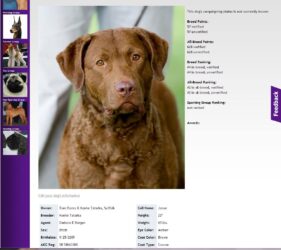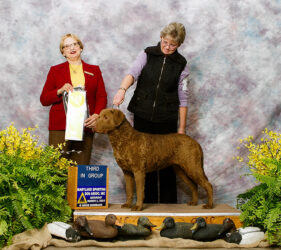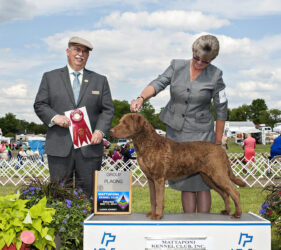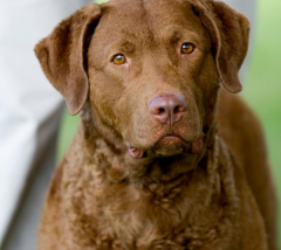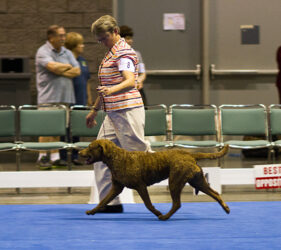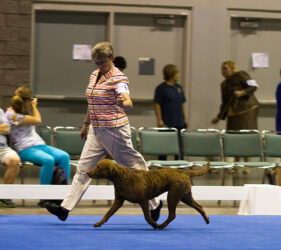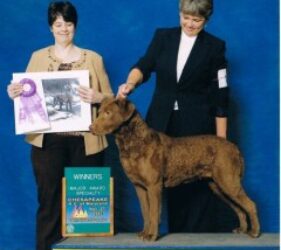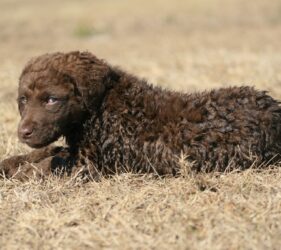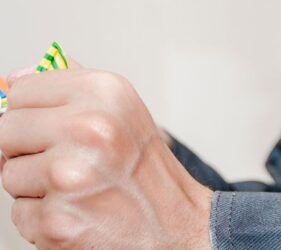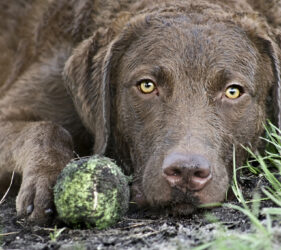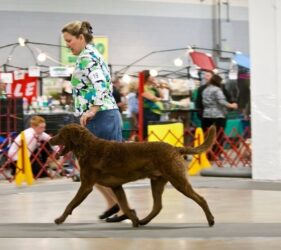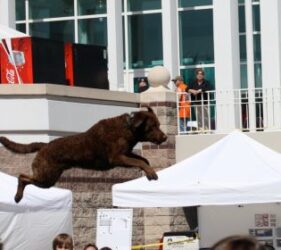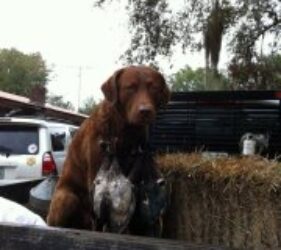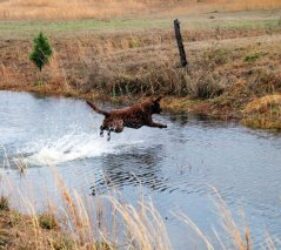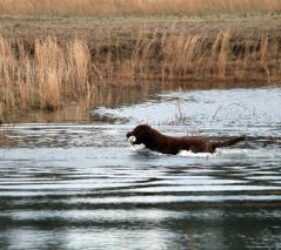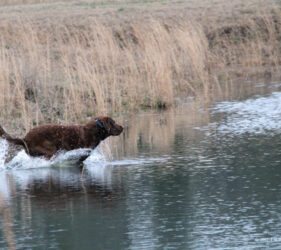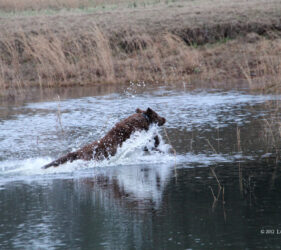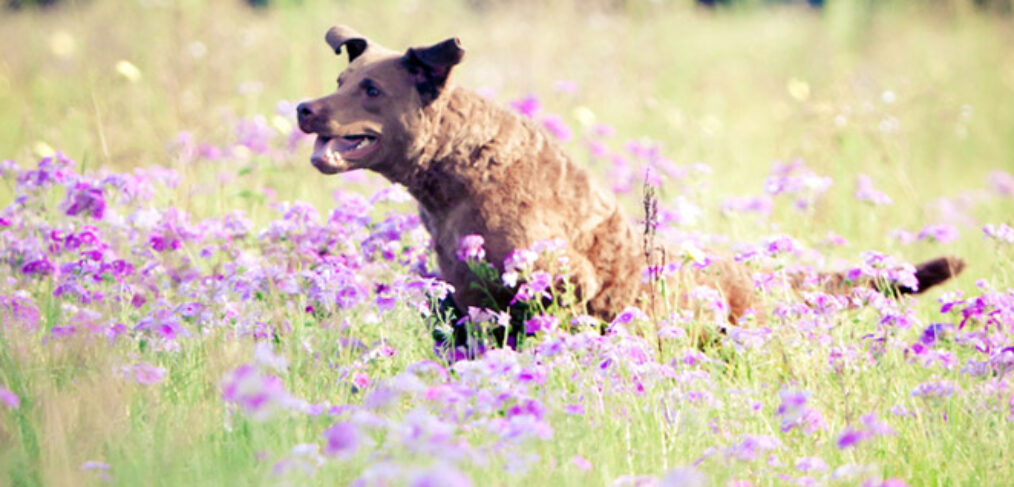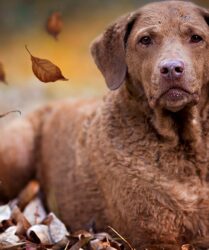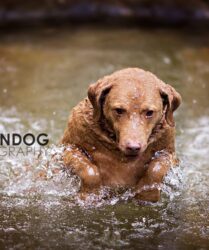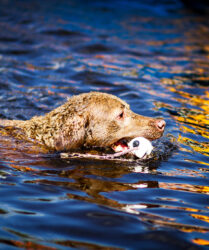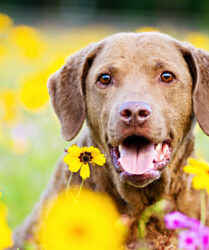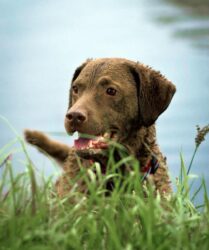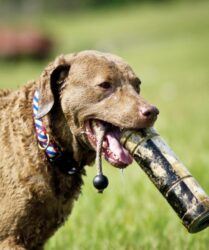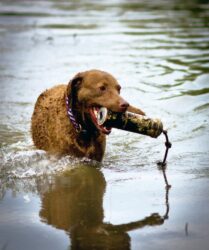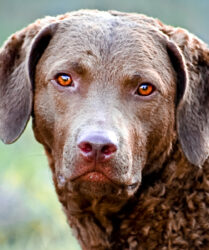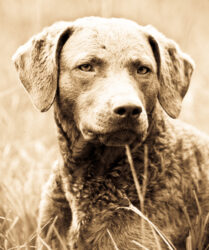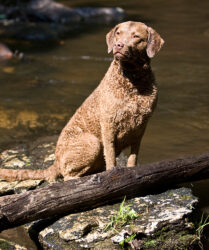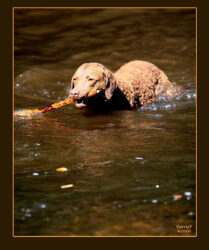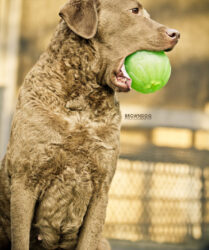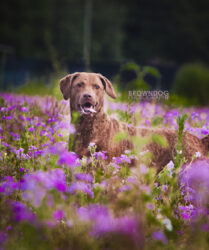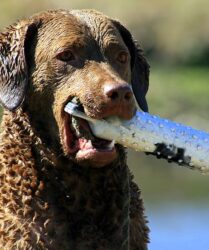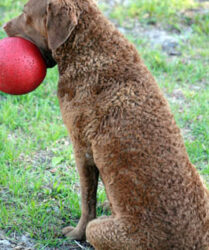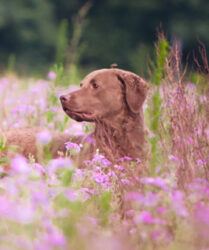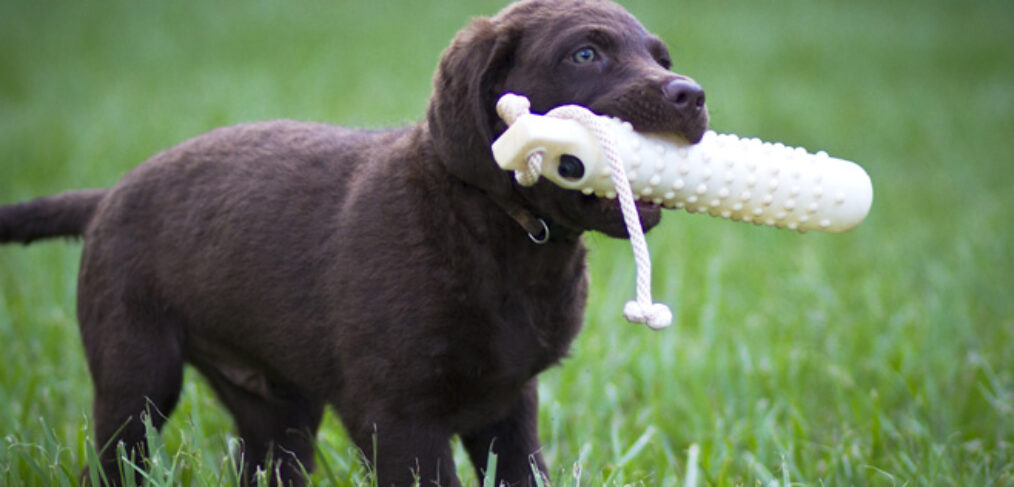Much of the information below is provided by the American Chesapeake Club, Teamchesapeake and ChessieInfo.net.
What is Degenerative Myelopathy?
Degenerative myelopathy (DM) is a progressive neurological disease that results in destruction of tissue within the spinal cord, usually in middle aged or older dogs. It is similiar to Amyotrophic Lateral Sclerosis (ALS or Lou Gehrig’s Disease) in humans. The disease’s onset usually occurs between 8 and 14 years of age.
The spinal cord is wrapped in a protecive membrane called the mylin sheath. Like insulation around an electrical cord, it protects the electral pathway of the nerves running down the dog’s spine. When this membrane becomes weak and starts to deterioate, it is known as a myelopathy (myelo=myelin sheath, pathy=disease). Once this protective layer deteriorates, the nerves themselves are at risk of degeneration. DM consists of both myelin and spinal cord nerve fiber degenration.
Since one of the most important functions of the spinal cord is to conduct signals from the brain to the nerves controlling the hind limbs, the principal clinical feature (visible symptom) of degenerative myelopathy is poor control over hindlimb function. Dogs with degenerative myelopathy show a lack of coordination in both hind limbs, together with a degree of muscle weakness.
DM starts slowly and affects the rear legs first. Early signs may go unnoticed by the owner. Slight dragging of a back foot, wearing of the toenails on the affected foot or feet can be an early sign. More advanced signs are dogs that might knuckle over on both paws, cross hind limbs (especially when turning in tight circles) and swing hind limbs wide or take abnormally long strides. Over time, the hindquarters become progressively weaker, until the dog can no longer support its own weight. Eventually, the disease leads to complete paralysis.
It is difficult to accurately diagnose DM as many other conditions can have similiar early symptoms. Injuries, bulging or ruptured vertebral disks, hip dysplasia, cruciate ligament ruptures, and many other things can show as a slight draggng of a hind foot, or wobbling when walking. To properly diagnose DM, all these other issues must be ruled out first before DM is considered. Diagnosis of the disease is only possible through magnetic resonance imaging (MRI) and cerebrospinal fluid (CSF) tap, or through autopsy. Even an MRI diagnosis can be incorrect as it does not pinpoint DM. An MRI only rules out other similiar diseases.
There is currently no available cure for DM. The disease inevitably progresses over a variable period of time – anywhere from 6 months to 3 years. Ultimately, affected dogs lose the ability to walk in both hind limbs and at this point, most owners elect for euthanasia.
How do Chesapeakes get DM?
DM is an inherited condition, and is polygenic in inheritance. This means that several genes, together with perhaps some environmantal factors, combine to create the disease in dogs. Currently, there is a DNA-based test for DM. It looks at only one of the genes that contributes to DM. The gene it identifies is simple recessive. The inheritance mode(s) of the other gene(s) involved with DM are unknown at this time.
What is a Polygenic Trait?
Polygenic trait:A Polygenic trait is controlled by two or more than two genes (usually by many different genes) at different loci on different chromosomes. These genes are described as polygenes.Every dog, and every human has “good” genes and “bad” genes. When the “good” genes outweigh the “bad” genes, this is considered normal phenotype. When the “bad” genes outweigh the “good” ones, this is considered affected phenotype.Affected dogs still have a certain number of good genes as well. An example of a polygenic trait in dogs is hip dysplasia (HD). HD is caused by many genes that control things like depth of hip socket, bone density, placement and strength of ligaments, tendons and muscles, size of femoral head, length and thickness of femoral neck, and so forth. If a dog has an overall greater number of bad genes for one or more of these traits, that dog will show up as dysplastic on x-ray. However, the dog will also still have some good genes at some of these loci. This is why a dog with bad hips can still produce non-dysplastic offspring, and vice versa, two x-ray normal dogs can still produce dysplastic puppies. A dysplastic dog, simply has fewer good genes to contribute, so it is less likely to produce overall improved hips in its offspring than a radiographically normal dog
A New Problem in Chesapeake Bay Retrievers?
Veterinary neurologists are familiar with DM because it is a common problem inGerman Shepherd dogs. From time to time sporadic cases have also been seen inother breeds. We are now seeing a growing number of Chesapeake BayRetrievers with the condition.
Knowing that this disease is strongly associatedwith particular breeds, it is possible that DM has a strong genetic component inCBRs as well. As yet we do not understand the cause; meaning, we do not haveenough data to ascertain whether the problem is due to a defect within a singlegene or defects in multiple genes acting in concert. More data and pedigrees needto be collected from dogs affected with DM to ascertain whether the problem isworth investigating further to try and locate a genetic component in the CBRbreed.
Trying to Eliminate the Disease
In 2008, a test became available which identifies “one” gene that contributes to DM. Results of the test are reported as clear, carrier, or at risk. At risk dogs are identifed as such, because having this gene alone may not cause the disease. It is an indicator that the dog *may* develop DM at some point, but it is not a certainty. Dogs testing as at risk can still be bred; owners should take into consideration the dog’s overall value as a breeding animal, and the test status of any mates when doing breedings.
Based on test result statistics, the frequency of this allele in Chessies seems high, so eliminating all carriers and all at risk animals would not be feasible. It would result in removing almost 60% of the breeding population. Obviously, this is not realistic. Instead, breeders should strive to reduce the occurrance of affected animals, by knowing their dogs’ testing status, as well as their bloodline’s tendency to actually develop DM symptoms. Carrier and at risk dogs from lines known to develop DM are a higher risk for producing affected offspring than dogs who test carrier or at risk, but are from lines where few or no animals actually develop symptoms.
Research is ongoing into causes and cures for this disease. The University of Missouri is still looking for dogs for its
ongoing DM study. Dogs over ten years old, whether symptomatic or not, are needed. This phase of the study is looking for further factors that contribute to DM. Non-symptomatic dogs over the age of ten who have tested At Risk are especially valuable, as they may have factors which prevent development of DM, even when the gene is present. To submit samples for research, contact the University of Missouri.



